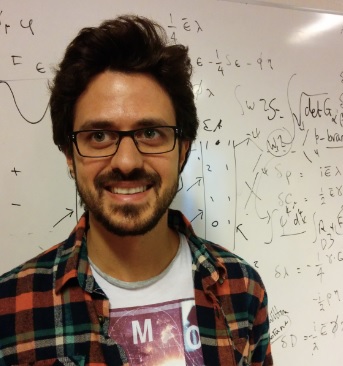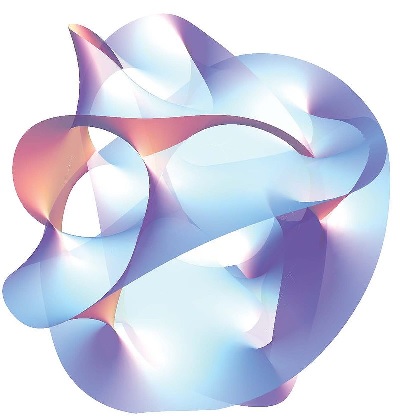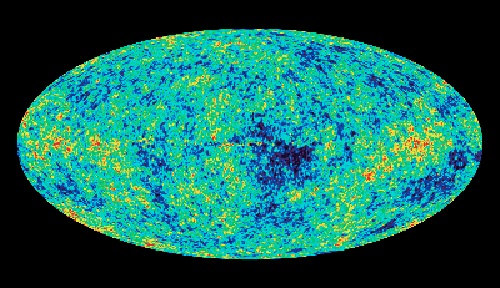One step closer to finishing Einstein’s work
Albert Einstein spent the last twenty years of his career trying to unify physics in one theory, without success. The most nagging aspect was his failure to describe gravity in terms of quantum mechanics. Physicists around the world are still working on the problem and believe they will find the answer by studying the early Universe. The cosmological models developed by University of Groningen PhD student Marco Scalisi promise significant progress.

Albert Einstein described most of physics in his Theory of Relativity, but at the very small scale of atoms and subatomic particles the laws of quantum mechanics dominate. As big things are made from little things, quantum mechanics and general relativity are somehow connected.
Over the years, physicists have managed to bring them together in most fields, but one phenomenon defies unification: gravity. There is no quantum description of gravity. Over the past few decades, attempts have been made to come up with a theory for quantum gravity. The most promising results are found in String Theory , which describes particles as multidimensional objects, in which most dimensions are ‘rolled up’ and invisible. That’s why we see just three dimensions, plus time.
Not feasible
‘String Theory is a very rich theory’, explains Marco Scalisi. That is not necessarily a good thing. Rich also means that the theory predicts many, many particles that haven’t been observed or can’t even be seen. The energies needed to find them far exceed those of the Large Hadron Collider, the most powerful particle accelerator built by man. ‘We need energies some fourteen orders of magnitudes higher than the LHC’, says Scalisi. That means 100,000,000,000,000 times higher, so it’s just not feasible.

This makes it very difficult to connect String Theory to real observations. But Scalisi’s research has opened up a novel perspective on this problem. He has studied the early Universe and found out that extremely high energy levels were indeed present just after the Big Bang. Traces of these can be seen in the Cosmic Microwave Background, as explained elsewhere by Scalisi’s PhD supervisor Diederik Roest.
Blown up
Cosmologists believe that the Universe expanded at a phenomenal rate right after the Big Bang. ‘And this inflationary phase acted as an amplifier, connecting the world of the very small to the world that we see’, explains Scalisi. Quantum fluctuations from the early Universe were ‘blown up’ by inflation, forming the seeds of the first stars and galaxies.
Scalisi set out to describe inflation in String Theory. This is a very challenging task and physicists usually decide to focus on certain limits of this complex theory. A seminal paper on this issue was written by Diederik Roest, together with Stanford University physicists Renata Kallosh and Andrei Linde . Kallosh was awarded an honorary doctorate by the University of Groningen in 2014, and her husband, Linde, is one of the founding fathers of inflation theory. Scalisi built on this work, and spent three months in Stanford working with Kallosh and Linde.
Inflaton
One of the many mysterious particles that String Theory might describe is the ‘inflaton’. ‘Just like you have an electron for electricity, or a graviton for gravity, you have the inflaton for inflation.’ And String Theory describes what is called the ‘internal geometry’ of the inflaton. Scalisi found that certain descriptions of this internal geometry result in predictions that fit well with observations. ‘Inflation leaves a footprint in the Cosmic Microwave Background, and my work connects this footprint to a particular set of geometries.’

The mechanism that causes this is typical of an ‘attractor’. This means that these microscopic internal properties simply force the predictions of disparate cosmological models to converge to a single point. What is striking is that this point is in firm agreement with observations.
The big breakthrough is that we now have some clear hints on how finally to connect String Theory predictions with observations. Of course, more work must be done, but this is definitely a novel starting point for future investigations. ‘It was really great to see that my theoretical work could actually be connected to observations. This was what I hoped for when I started my PhD research.’
The three months in Stanford were another great experience during his PhD project. ‘I worked day and night, but it was so inspiring to be there. Kallosh and Linde were both very accessible, and there were great discussions in the corridors.’ Scalisi is now working as a postdoc in Hamburg, with Alexander Westphal . ‘He is an expert on String Theory, and is working on inflation, so this is the right place for me to continue my work!’
Marco Scalisi defended his PhD thesis Inflation, Universality and Attractors on 13 June at the University of Groningen
| Last modified: | 08 September 2020 3.39 p.m. |
More news
-
16 April 2024
UG signs Barcelona Declaration on Open Research Information
In a significant stride toward advancing responsible research assessment and open science, the University of Groningen has officially signed the Barcelona Declaration on Open Research Information.
-
15 April 2024
Single-molecule engineering niche in Gravitation research
With her expertise in single-molecule techniques, Dr. Kasia Tych (GBB) will contribute to a big Grvitation-research programme
-
15 April 2024
Night vision with artificial atoms
Every two weeks, UG Makers puts the spotlight on a researcher who has created something tangible, ranging from homemade measuring equipment for academic research to small or larger products that can change our daily lives. That is how UG...

